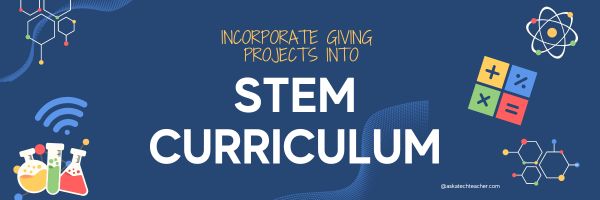Adding monthly giving projects to STEM classes helps students learn important skills like problem-solving and teamwork while also teaching them to care about their communities. For example, my class once built a website to raise funds for a local animal shelter, which taught us web development and the value of helping others. Sound interesting? The Ask a Tech Teacher team has ideas on how to incorporate giving into your STEM curriculum:
Incorporating Monthly Giving Projects into STEM Curriculum: Inspiring the Next Generation of Philanthropists
STEM equips students with critical thinking, problem-solving, and innovative skills vital for their future careers. But what if we could also use STEM to inspire the next generation of philanthropists?
Incorporating philanthropy into education is a noble endeavor. Some may even argue that it’s a necessary one.
As educators and society recognize the importance of nurturing well-rounded individuals, monthly giving projects are gaining traction within STEM curriculums. These initiatives enrich the educational experience and inspire students to become lifelong contributors to their communities. Let’s get into it.
An Overview of STEM – Why It’s Relevant and Important
STEM stands for Science, Technology, Engineering, and Mathematics. These fields are the foundation for innovation and progress in various industries such as healthcare, transportation, communication, etc.
The skills developed through STEM education allow students to think critically, problem-solve creatively, and adapt to rapidly changing technological advancements. With the addition of philanthropy projects, compassion and empathy come into play.
Students can learn the ins and outs of who benefits and how they can help and marketable skills like sales and building responsive fundraising techniques.
According to the National Science Foundation (NSF), STEM jobs are projected to grow faster than non-STEM jobs, making it a promising career path for students.
However, STEM’s lack of diversity is still a major concern. This is where incorporating philanthropy into the STEM curriculum can make a difference.
The Benefits of Incorporating Monthly Giving Projects into STEM Curriculum
Monthly giving projects have numerous benefits for both students and their communities. Some of these include:
- Developing empathy and compassion: Monthly giving projects allow students to learn about social issues and the struggles faced by individuals in their communities.
- Promoting civic engagement: Through monthly giving projects, students can actively participate in their community and make a positive impact. This promotes a sense of civic responsibility and encourages students to become engaged citizens.
- Enhancing critical thinking and problem-solving skills: Monthly giving projects require students to think critically, identify problems, and develop creative solutions. These skills are essential in STEM and can be applied to real-world situations.
- Fostering teamwork and collaboration: Many monthly giving projects involve working in teams, allowing students to develop essential team-building skills. These skills are highly valued in the workplace and will benefit students in their future careers.
- Providing hands-on learning experiences: Monthly giving projects allow students to apply the knowledge they learn in the classroom to real-world situations. This hands-on experience makes learning more meaningful and engaging for students.
Creating Lesson Plans
Teachers can design lesson plans that blend technical skills with philanthropy to successfully integrate monthly giving projects into the STEM curriculum. Here are a few ideas to help you get started.
Coding Projects
Example: Build a Fundraising Website
- Objective: Teach students how to create a simple website using HTML, CSS, and JavaScript.
- Activity: Each student or group creates a fundraising page for a chosen charity.
- Outcome: Students learn web development while supporting a cause.
Data Analysis Projects
Example: Analyzing Charity Impact
- Objective: Use data analysis tools like Excel or Python to interpret data from charitable organizations.
- Activity: Students collect and analyze data on the impact of donations over time.
- Outcome: Students gain proficiency in data analysis and understand the importance of transparency in philanthropy.
Project Management
Example: Organize a Fundraising Campaign
- Objective: Teach project management principles such as planning, execution, and monitoring.
- Activity: Students plan and execute a fundraising campaign using project management software to track progress.
- Outcome: Students develop organizational skills and experience project management challenges.
Practical Guide to Implementing Monthly Giving Projects
Here’s our practical framework for implementing giving projects into your STEM curriculum. This step-by-step guide is flexible enough to allow teachers to take the ideas below and make them their own.
Identify a Cause
Begin by researching and identifying causes that resonate deeply with your students and align seamlessly with your STEM curriculum.
These causes could range from environmental initiatives, like recycling programs or community gardens, to technological advancements to solve local issues.
Engage students in discussions to gather their interests and perspectives to ensure the cause chosen excites and motivates them.
Plan the Project
Next, develop a comprehensive project plan. You’ll want to include clearly defined objectives detailing what you aim to achieve through the project.
Establish a realistic timeline by breaking the project into manageable phases with specific milestones.
Determine the resources required like materials, funding, and human resources.
Assign roles and responsibilities to give everyone a clear understanding of their contributions. Use templates and project management tools to map out the entire project, providing a visual guide for students and facilitators to follow.
Engage Stakeholders
Effective stakeholder engagement can make all the difference. To build a robust support network, involve students, parents, and local community members from the onset.
Organize informational sessions and workshops to present the project’s vision and goals. Establish committees or groups consisting of students, parents, and community leaders to gather continuous feedback and support.
Foster partnerships with local businesses, non-profits, and other educational institutions to gather resources and expertise that can enhance the project’s impact.
Execute with Students
You’ll need to guide students through the execution phase with careful planning and support. Facilitate hands-on learning opportunities that allow students to apply their STEM knowledge practically.
Organize regular check-ins and progress meetings to address challenges. Encourage collaborative and team-based approaches to problem-solving.
Provide mentorship and coaching to help students overcome obstacles and stay motivated. Celebrate milestones and achievements to maintain enthusiasm and commitment throughout the project duration.
Reflect and Iterate
Hold reflective sessions with students, teachers, and stakeholders upon project completion to evaluate the project’s success and impact.
Discuss what worked well, what challenges were faced, and how they were overcome. Encourage open and honest feedback to gather insights for improvements. Document lessons learned and best practices to inform future projects.
A Few Final Thoughts
Integrating monthly giving projects into the STEM curriculum offers many benefits that extend far beyond academic achievement. Educators can cultivate critical thinking, problem-solving, teamwork, and hands-on learning by engaging students in philanthropy through coding, data analysis, and project management.
The practical guide provides clear steps to identify a cause, plan effectively, engage stakeholders, execute with precision, and reflect thoughtfully.
These initiatives enhance students’ technical skills and foster a sense of civic duty, shaping them into compassionate, responsible citizens. By combining technical education with the power of giving, we can inspire the next generation of innovators to build a better world. For further reading, check out this post on summer activities.
–image credit to Deposit Photo
–image credit to Deposit Photo
Here’s the sign-up link if the image above doesn’t work:
“The content presented in this blog are the result of creative imagination and not intended for use, reproduction, or incorporation into any artificial intelligence training or machine learning systems without prior written consent from the author.”
Jacqui Murray has been teaching K-18 technology for 30 years. She is the editor/author of over a hundred tech ed resources including a K-12 technology curriculum, K-8 keyboard curriculum, K-8 Digital Citizenship curriculum. She is an adjunct professor in tech ed, Master Teacher, webmaster for four blogs, freelance journalist on tech ed topics, contributor to NEA Today, and author of the tech thrillers, To Hunt a Sub and Twenty-four Days. You can find her resources at Structured Learning.






































